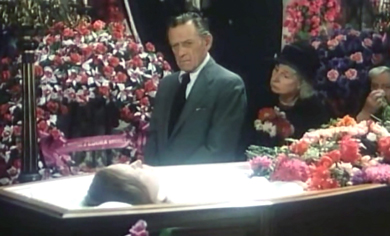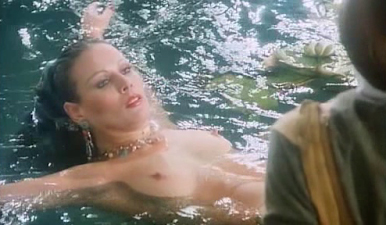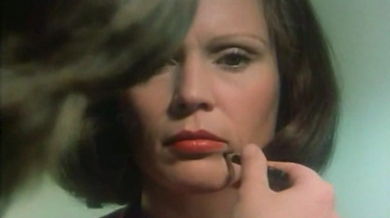
 |
|
|
|
Billy Wilder is credited as director on only twenty-six feature films spanning about forty-five years. Although English was his second language he's possibly the best wordsmith ever in American movies. Throughout his career his work was simply smarter and brighter than the competition. Although criticized as cynical, his movies perpetuated the sweet romantic ironies of Ernst Lubitsch; when he went truly dark his films noir expressed a dread not found in most horror movies. Wilder's last decade produced an uneven string of pictures. He'd undergone course corrections before when going too far in one direction or another, after flops like Ace in the Hole and Kiss Me Stupid. Wilder said that back in the 1920s he learned a lot of English through the lyrics of the American songs he loved. I can't see him finding much of any personal connection to the songs of the 1970s. The culture eventually changed enough so that nothing he did seemed to be right. The world didn't deserve his 1970 The Private Life of Sherlock Holmes, a masterpiece jammed with the love of classic filmmaking. Likewise nobody wanted to see Wilder's charming farce Avanti! with its emphasis on middle-age "hang-ups" (sic). The Front Page seemed a desperate effort to make the Lemmon-Matthau magic happen again, and his last film Buddy Buddy yet another remake where his favorite actors suddenly seemed like irritating clowns, trying too hard. Wilder hadn't lost his sense of humor or his ability to direct, but a world that celebrated Richard Pryor seemingly had little more use for him. 
This brings us to 1978's Fedora. At first it seems like another desperation move, a re-think of one of Wilder's own greatest films, bankrolled by some German investors. It was given a weak release and has been more difficult to come by than most of Wilder's pictures. 1 Down on his luck producer Barry "Dutch" Detweiler (William Holden) travels all the way to the Greek island of Corfu in the hope of luring legendary star Fedora (Marthe Keller) out of retirement. He's met with heavy resistance -- Fedora lives on a private island, watched over by her friends The Countess Sobryanski (Hildegard Knef) and discredited plastic surgeon Doctor Vando (José Ferrer). But Dutch eventually makes contact with Fedora, who seems disturbed and disoriented -- and unaccountably youthful-looking, the result of Dr. Vando's work. No matter how much they claim otherwise, Detweiler becomes convinced that Fedora's 'friends' are holding her against her will. Nurse Balfour (Frances Sternhagen) orders Fedora about as if she were a prisoner. Fedora seems to be taking a tour through all of Wilder's work, and the work of others as well. It begins with a Hollywood insider who has a flashback at the funeral of a great star (The Barefoot Contessa). It then journeys to a romantic Mediterranean setting with an amusing hotelier (Avanti!). The idea of a perhaps-mad star undergoing radical plastic surgery seems a melding of Sunset Blvd. and Les yeux sans visage, with mirrors removed from the house. A fictitious movie called Half-Moon Street is mentioned, when there's a real horror film with a similar title that's about a man who uses murderous means to make himself forever youthful. The 'Plastic surgery madness' also evokes images and ideas about disfigurement from A Woman's Face (or this version. 
Fedora's wild love life as a movie actress included a 1947 one-night affair with a much younger Dutch Detweiler (Stephen Collins). Fedora's list of celebrity conquests reminds us of Audrey Hepburn's fantasy lovers in Love in the Afternoon. Finally, a major make-over/identity transformation seems patterned after scenes in Vertigo and also the "Vertigo" pretender The Legend of Lylah Clare. Wilder's Fedora is deeper into movie lore than Sunset Blvd. ever was, for a different purpose. Wilder's daring script piles on the gothic angles and too-familiar situations. Just beyond the halfway mark it executes a jarring narrative switcheroo -- the story stops, and then doubles back to explain itself. It's like nothing Wilder and I.A.L. diamond ever did before, so we have to assume that they liked it (the story source is from actor-turned novelist Tom Tryon). In terms of adding meaning and depth to the tale, this extended flashback explanation is fairly successful; I can see it working very well on the printed page. In the movie we feel like the story has already concluded, and we're spending a second hour listening to characters re-tell parts that we didn't know about the first time through. 
In other words, the movie has an early 'conclusion' as final as the finish of Anna Karenina, and then re-starts as a new movie. That's when we learn the truth about the domineering Countess, and the mysterious Dr. Vando. Unlike Sunset Blvd. there's no marvelous, bigger-than-life Norma Desmond character to enjoy. Marthe Keller is what remains of the great Fedora, and her greatness is established by those around her -- their stories, their flashbacks. In Detweiler's flashback the imperious star feels insulted when young assistant director Dutch wades into her sexy pond scene and doesn't react to her nudity. After determining that he's not gay, she spends the night with him making love on the beach. This is the only time we see the legendary Fedora in her prime. She seems an echo of Tamara Toumanova's amusing ballerina in The Private Life of Sherlock Holmes. In negotiating for sex with Sherlock, the issue of a long list of lovers comes up (again), along with similar doubts about Sherlock's heterosexuality. The second half of Fedora mainly serves as a crazy critique of its movie-star-as-monster. There's never much suspense, because the Big Narrative Twist is all but telegraphed on a neon sign. 2 What's revealed about the Fedora character is sadder and darker than even Norma Desmond's story. Without giving anything away, the lesson of Fedora's horrible life is that Fedora was/is so caught up in her glamorous stardom that she'll happily sacrifice her own daughter to sustain the legend. Said another way, the worship of screen illusion is evil because the worst Hollywood people will eat their own young to perpetuate their 'greatness'. Just ask Joan Crawford. 
When asked about the possibility of a film biography, the aged Fedora asks, "but who would you get to play it?" Billy Wilder must be commenting on his own dilemma, because he later admitted that he had difficulty casting the movie. For all her good efforts Marthe Keller is sort of a cipher for glamour and greatness that the rest of the movie must work overtime to establish. Of course, we're all thinking about Greta Garbo, who when filming began was only 72 years of age. If the great actress desired to return to the screen it would surely have been for somebody like Billy Wilder -- he of course co-wrote her marvelous Ninotchka. But this story would not seem an even remotely attractive prospect. 3 William Holden said more than once that he would walk through fire for Billy Wilder and his appearance gives the movie a solid center. The great beauty Hildegard Knef has the movie's scariest role. She was unfairly dubbed an "ice queen" by Hollywood, and starred in post-war Germany's first anti-Nazi movie, The Murderers Are Among Us. José Ferrar is also excellent, although his role isn't given much in the way of clever dialogue... Wilder and I.A.L. Diamond's script is mostly more serious than usual. Mario Adorf is amusing and friendly as the manager in Detweiler's hotel. Familiar face Gottfried John is excellent in a smaller role -- twenty years later he would play the renegade Soviet general in Goldeneye. 
Just this year, a documentary was released called Swan Song: The Story of Billy Wilder's Fedora. It reportedly has interviews with many of the participants, including Michael York, who appears as himself. Henry Fonda also appears as himself in the movie, but I haven't explained their roles so as to not to divulge any more of the plot. There are surely viewers that will enjoy Fedora better without having its mechanics spoiled; and lovers of Billy Wilder want to see all of his pictures with an uncluttered mind -- even Buddy Buddy or The Emperor Waltz.
Olive Films' Blu-ray of Fedorais a very good HD restoration performed in 2013 by the film's German owners. The image sometimes seems a trifle soft but that may be due to filtering to shave some years from the aging William Holden. Shots with opticals, particularly the opening and closing, look very soft, which may be because of the original optical work wasn't of the highest quality. But overall color
Not to be overlooked is Miklos Rozsa's unmistakable music score, which is only occasionally highlighted but adds to the flavor of drama and suggests an Old Hollywood context. Olive Films' welcome presentation has no extras.
On a scale of Excellent, Good, Fair, and Poor,
Fedora Blu-ray rates:
Footnotes:
1. People on Sunday and Mauvaise Graine were difficult to see until the DVD years, and Buddy Buddy is available in Europe. So all of Wilder's remarkable filmography can now be watched end-to-end. Sometimes I wish there were more Wilder pictures to discover... all that's left for me personally are a couple of '30s films that he wrote or co-wrote.
2. It's interesting that Billy Wilder's stories have plenty of crazy coincidences, but except for his Agatha Christie movie, no sneaky narrative switcheroos until this one. Barry Detweiler describes the events of his trip to Corfu as if they were a badly plotted old movie. Incidentally, Billy Wilder was mercilessly critical of his brother W. Lee Wilder, who for about ten years was a low budget moviemaker. Two of his movies were borderline films noir in which exaggerated 'twist' plot developments were 'the whole show'. Many viewers will think that Fedora is just as rickety, if they don't look to see what's beyond its clichéd plot construction.
3. A few years earlier, National Lampoon magazine made fun of Greta Garbo's fabled seclusion in a gag article called "Unlikely Events of 1972". Her illustrated cartoon panel read, "Greta Garbo Comes out of Hiding to Appear on TV's Celebrity Bowling". The illustration showed Garbo, wearing dark glasses, bowling a strike.

Reviews on the Savant main site have additional credits information and are often updated and annotated with footnotes, reader input and graphics.
Review Staff | About DVD Talk | Newsletter Subscribe | Join DVD Talk Forum |
| ||||||||||||||||||